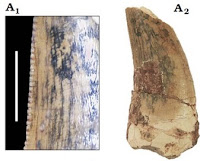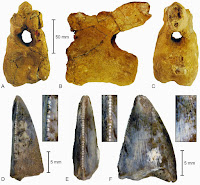Cretaceous deposits in Morocco and at other sites across North Africa have produced a large assemblage of Dinosaur remains, with the most abundant finds being medium-to-large Theropods, particulary Abelisaurids, Carcharodontosaurids, and Spinosaurids. No known modern terrestrial environment is dominated by large predators in this way, suggesting that either North Africa had a very strange ecological network in the Middle Cretaceous, or that the known fossil assemblage has been influenced by either taphonomic or collecting bias (i.e. either the bones of large Theropods have been preferentially preserved for some reason, or collectors are overlooking bones from other groups).
In a paper published in the journal Peer J on 29 February 2016, Alfio Alessandro Chiarenza of the Department of Earth Science and Engineering at Imperial College London and Andrea Cau of Earth, Life and Environmental Sciences at the University of Bologna and the Giovanni Capellini Geological and Palaeontological Museum, describe a partial femur of a large Theropod from the Late Cretaceous of Morocco.
The specimen was collected by local artisanal fossil collectors, and sold by a Moroccan trader to a buyer who donated it to the Gaetano Giorgio Gemmellaro Geological and Palaeontological Museum in Palermo. As such it does not come with complete location and horizon information, however the matrix in which the fossil is preserved is consistent with sediments from the Kem Kem Compound Assemblage in the Taouz Region of Errachidia Province, close to the border with Algeria. This would make the specimen Cenomanian in age, i.e. between 100.5 and 93.9 million years old, dating from the earliest Late Cretaceous.
The specimen comprises the proximal end of a right femur (i.e. the part of the upper leg bone closest to the trunk) including the head, neck and trochanteric region. This is assigned to an Abelisaurid, but not described to species level due to its fragmentary nature, indeed Chiarenza and Cau argue strongly against the describing of new North African Theropod taxa from fragmentary remains, and note that many named species have been described from such limited remains that no further specimens could ever be confidently identified as having come from the same species.
Abelisaurid femur from the Kem Kem Compound Assemblage of Morocco. (A) proximal view, (B) anterior view, (C) medial view, (D) posterior view, (E) lateral view, (F) distal view (not at same scale as other views). Scale bars are 5 cm. Abbreviations: gt, greater trochanter; iMie, insertion for the M. iliofemoralis externus; fn, femoral neck; s, shallow sulcus. Chiarenza & Cau (2016).
The specimen is reconstructed to have been at least 776-924 mm in length, and possibly as long as 1200 m. Even the most conservative estimate of the complete size of this bone suggests an animal weighing around 1850 kg, suggesting an animal towards the upper end of the known range for Abelisuarids (or any closely related group), suggesting that these Dinosaurs were already reaching very large sizes by the Cenomanian, somewhat earlier than has previously been suggested.
See also...
 Isolated Theropod teeth from the Middle Jurassic of Niger. Unlike Mammals, Dinosaurs
replaced their teeth throughout their lives, continuously growing new teeth and
shedding older, worn ones. This, combined with the hard enamel coating found on
all vertebrate teeth, makes isolated teeth the most commonly...
Isolated Theropod teeth from the Middle Jurassic of Niger. Unlike Mammals, Dinosaurs
replaced their teeth throughout their lives, continuously growing new teeth and
shedding older, worn ones. This, combined with the hard enamel coating found on
all vertebrate teeth, makes isolated teeth the most commonly... Dinosaur remains from northwestern Saudi Arabia. Dinosaurs are the most distinctive element of Mesozoic Vertebrate
faunas, arising in the Triassic, and coming to dominate all known
terrestrial ecosystems during the Jurassic and Cretaceous, before
disappearing abruptly (other than the still extant Birds) at the end of
that period. Despite this widespread distribution, very...
Dinosaur remains from northwestern Saudi Arabia. Dinosaurs are the most distinctive element of Mesozoic Vertebrate
faunas, arising in the Triassic, and coming to dominate all known
terrestrial ecosystems during the Jurassic and Cretaceous, before
disappearing abruptly (other than the still extant Birds) at the end of
that period. Despite this widespread distribution, very... A new species of Theropod Dinosaur from the Late Jurassic of Portugal. The Late Jurassic Megalosaurid Theropod Dinosaur...
A new species of Theropod Dinosaur from the Late Jurassic of Portugal. The Late Jurassic Megalosaurid Theropod Dinosaur...
Follow Sciency Thoughts on Facebook.

